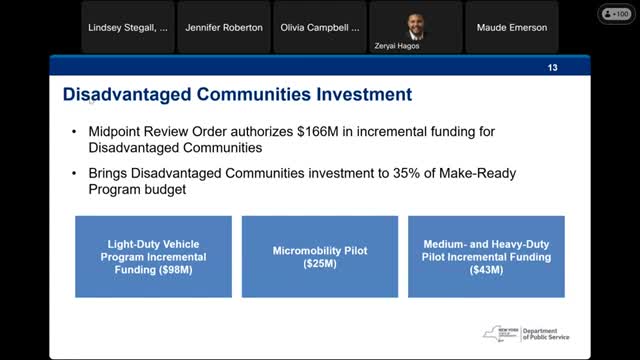New funding boosts clean transportation in disadvantaged communities
December 21, 2023 | Department of Public Service, State Agencies, Executive , New York

This article was created by AI summarizing key points discussed. AI makes mistakes, so for full details and context, please refer to the video of the full meeting. Please report any errors so we can fix them. Report an error »

In a recent government meeting, officials discussed significant advancements in the Electric Vehicle (EV) Make Ready program, particularly focusing on investments aimed at promoting clean transportation solutions in disadvantaged communities. The midpoint review order mandates that at least 35% of the total program budget be allocated to these communities, amounting to $166 million across three key areas: the light-duty make ready program, a new micro-mobility pilot, and additional funding for medium and heavy-duty vehicle initiatives.
The light-duty make ready program is set to provide enhanced incentives covering up to 100% of eligible costs for charger installations in disadvantaged areas. Notably, the eligibility criteria for these incentives have been updated. The previous radius requirement for Level 2 chargers has been eliminated statewide, allowing for more direct support within disadvantaged communities. Additionally, curbside Level 2 chargers will now be eligible for incentives, addressing the needs of residents in multi-unit buildings without off-street parking.
To ensure equitable funding distribution, the order introduces premise-specific eligibility requirements for multi-family buildings in Con Edison’s service territory, limiting enhanced incentives to affordable housing. This measure aims to prevent wealthier buildings within disadvantaged areas from disproportionately benefiting from the program.
The micro-mobility pilot program, developed in response to stakeholder feedback, will provide $20 million in incentives for charging stations for e-bikes and scooters in downstate regions, while upstate will receive $5 million for a grant program to support similar initiatives. This approach recognizes the transportation needs of residents who may not own cars, thereby promoting broader access to clean transportation options.
Overall, these initiatives reflect a commitment to fostering sustainable transportation solutions while addressing the unique challenges faced by disadvantaged communities. The meeting concluded with a question-and-answer session, allowing stakeholders to engage further with the proposed changes.
The light-duty make ready program is set to provide enhanced incentives covering up to 100% of eligible costs for charger installations in disadvantaged areas. Notably, the eligibility criteria for these incentives have been updated. The previous radius requirement for Level 2 chargers has been eliminated statewide, allowing for more direct support within disadvantaged communities. Additionally, curbside Level 2 chargers will now be eligible for incentives, addressing the needs of residents in multi-unit buildings without off-street parking.
To ensure equitable funding distribution, the order introduces premise-specific eligibility requirements for multi-family buildings in Con Edison’s service territory, limiting enhanced incentives to affordable housing. This measure aims to prevent wealthier buildings within disadvantaged areas from disproportionately benefiting from the program.
The micro-mobility pilot program, developed in response to stakeholder feedback, will provide $20 million in incentives for charging stations for e-bikes and scooters in downstate regions, while upstate will receive $5 million for a grant program to support similar initiatives. This approach recognizes the transportation needs of residents who may not own cars, thereby promoting broader access to clean transportation options.
Overall, these initiatives reflect a commitment to fostering sustainable transportation solutions while addressing the unique challenges faced by disadvantaged communities. The meeting concluded with a question-and-answer session, allowing stakeholders to engage further with the proposed changes.
View full meeting
This article is based on a recent meeting—watch the full video and explore the complete transcript for deeper insights into the discussion.
View full meeting
